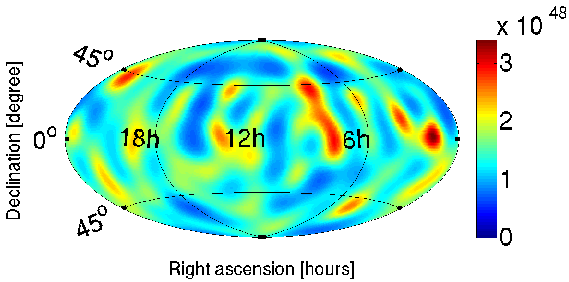The Laser Interferometer Gravitational-wave Observatory (LIGO) Scientific Collaboration and the Virgo Collaboration have produced a sky map limiting the strength of persistent gravitational-wave sources.
Measurements from microwave astronomy have taught us that the sky is illuminated with a complicated structure. While distant stars appear “point-like,” their combined glow in our Milky Way galaxy creates an extended source spreading across the sky. And in every direction, there exists the cosmic microwave background—an afterglow of the Big Bang. The gravitational-wave sky may be similarly rich in structure. For example, nearby neutron stars—extremely dense old stars, which have burned away all of their nuclear fuel—may appear as gravitational-wave “point sources.” Meanwhile, a gravitational-wave background, analogous to the cosmic microwave background is expected to arise, for example, from the combined gravitational-wave emission of all the neutron-star binary mergers in the universe. At any given time, and at various locations in the visible universe, it is estimated that between one and ten neutron star binaries are emitting gravitational waves at frequencies accessible by LIGO. The gravitational-wave background may even include a significant contribution from the Big Bang itself. The theory of inflation, which explains the observed uniformity of the cosmic microwave background, predicts that quantum fluctuations in the fabric of spacetime may have created a gravitational-wave “echo” of the Big Bang. Observation of this inflationary signal may someday allow scientists to study the dramatic first moments of the infant universe.
In order to disentangle the many possible sources of persistent gravitational waves, LIGO and Virgo scientists have embarked on a program to map the gravitational-wave sky. Although no persistent gravitational wave features were identified in the sky, LIGO and Virgo scientists produced the first ever sky maps limiting the strength of arbitrary persistent gravitational waves (arriving from different directions on the sky).

A sky map of upper limit on the gravitational-wave strain power (units=strain2Hz-1sr-1). We are confident at the level of 90% that the true gravitational-wave power across the sky is below these levels. The different colors exhibit fluctuations due to detector noise. No gravitational-wave signal was detected.
LIGO and Virgo researchers also paid special attention to several sky locations associated with interesting astronomical objects. Among them is Scorpius X-1, a nearby X-ray binary and the second brightest X-ray source in the sky after the sun. Low-mass X-ray binaries such as Scorpius X-1 are binary systems in which one object is either a neutron star or a black hole. Black holes, formed from the collapse of super-massive stars, are the most compact objects in the universe. Mass is pulled from the lower-mass object onto its higher mass companion where it is heated and emits X-rays before being devoured by the high-mass companion. Such systems are also promising sources of gravitational waves. The gravitational-wave frequency spectra from Scorpius X-1 and two other objects were analyzed. No gravitational-wave signals were observed and so LIGO and Virgo scientists set upper limits on the gravitational-wave emission.

Upper limits on the gravitational-wave strain associated with the low-mass X-ray binary, Scorpius X-1, as a function of gravitational-wave frequency. We are confident at the level of 90% that the true gravitational-wave strain from Scorpius X-1 is below these levels. The red line shows the current upper limits and the green line shows the previous best upper limits. The blue and black lines show the sensitivity of current and previous results. The shape of the spectrum is due to LIGO’s noise spectrum and the spikes are due to instrumental artifacts. A strain of 10-24 corresponds to movement of LIGO’s mirrors of approximately 10-21 m—one millionth the diameter of the proton.
These results, obtained using data from LIGO’s fifth science run (S5), provide a new paradigm for mapping the gravitational-wave sky. This new paradigm is expected to play an important role for analyses using data from the upgraded Advanced LIGO/Virgo experiments, which are expected to achieve a factor of at least a hundred better sensitivity than this analysis. Advanced LIGO is scheduled to become fully operational within a few years.
Read more:
- The publication describing the analysis (arXiv) (PRL)
- Repository of data used in the publication

